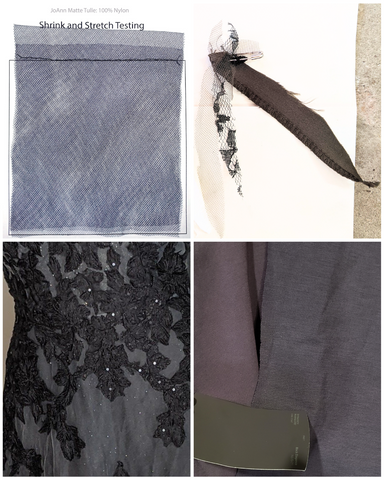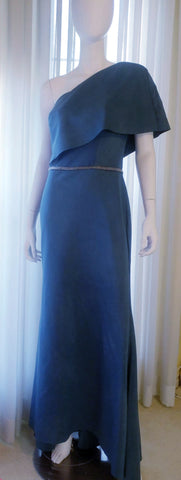
What to Expect with Dyeing Your Dress
Share
With the Renegade Dye Lab now open (to bridal gowns beyond our own collection of nontraditional delights with pops of color), it has become necessary to back up and share a bit of education with brides about which fabrics dye best or not at all, stretch and shrink, and all kinds of textile science fun.
There are a few considerations. We'll cover most in this post, but definitely be expanding upon some aspects and adding more visual aids in forthcoming posts.
- What to shop for
- When to alter
- What to expect from each fabric
- The process
Before we dive in, a quick disclaimer for the first but not the only time. We never promise a result without your swatch test and some inherent trust. Gown dyeing is both an art and science. There is finesse involved, and an element of imperfection typical of hand work arises - a wrinkle that takes pigment and leaves a line, perhaps. If you're looking for a guarantee of perfection, printing your ombre might be a better solution.
Quick note about aiming for black
Where it takes 4 drops to achieve blush on an entire ballgown, it can take pounds of pigment to achieve black. Black dyed gowns among both the most challenging colors to dye. Any resistance from a fabric at all tends to make pushing from a charcoal to a satisfying black really challenging. We've had some tests top out at charcoal and others an eggplant shade (as black dye is just very saturated blue and red pigment).
Black is also our most popular request, but we schedule only one at a time. Please allow for a generous booking period so that we may give your gothic beauty the attention she deserves.
What To Shop For
Speaking of imperfections, let's get into the kinds of gowns which we recommend most highly.
Silk
Silk is generally only found at luxury price tiers in bridal, the remainder of our Almanac will assume your gown is a polyester or other synthetic (vs natural fiber silk). As a natural fiber, silk does take dye well.
In fact, if you've been asking about dyeing in a bridal store, you may have been misinformed that only silks and natural fibers will dye. That is incorrect. Lots of fabrics are dyeable! This common misconception is understandable, though. If we were talking about your run-of-the-mill dye from the craft store, they would be right.
We dye using nontoxic industry-grade disperse dyes, not a basic reactive dye. The process necessitates a prolonged, heated bath (that's where the aforementioned finesse comes in). In other words, we're professionals using professional, proprietary processes and dye formulas we've been perfecting for 15 years.
Styles That Work Well for Ombre Dip Dyeing
All sorts of different effects are possible with all sorts of different styles! That said, we do find that styles with multiple layers of soft tulle and/or lace are highly suitable. If you're drawn to these airy, romantic looks, then consider yourself off to a good start.
Above, we discussed the hand artistry inherent in our process. When you can dye layers separately, though, it allows a sort of filtering effect that softens and blends away any spots where maybe the dye absorbed a little lighter or darker. Sticking to this style is not at all critical, but we're often asked if there's an optimal kind of gown.

|
Fabrics That Work Well for Dyeing
Tulle
Caution: not all tulles and netting are created equal. In general, softer is better.
Soft tulles (usually polyester) tend to take color very quickly and vividly. The more crisp varieties (usually nylon) usually require the full 30+ minute time in the dye bath, which can cause notable shrinkage. The result looks fine; nobody can tell by looking that the holes in your tulle are slightly smaller than before.
We've seen 3 or more inches shrink up from hem length, though. For a short bride, this might cause no issue. For average to tall brides, though, we might recommend leaving some of your top layers undyed in order to retain the full length. Slightly shorter layers are often well hidden this way.

Lace
Laces are often combined with multiple fiber elements. For instance, a corded lace may have the base embroidered applique in polyester, but the cord in nylon. These laces will have a multidimensional result due to the variation.Chiffon
Results on chiffon have consistently been vivid. There's a catch, though. This sheer, billowy textile gets its characteristically diaphanous features from it's very loose weave. When chiffon gowns get wet and thus heavy, the weight of the wet gown itself is enough to stretch your hem approximately 5 inches longer than when we started. Does it look different? No. Does this effect your strategy for how and when to do alterations? It will. For our very short brides, we recommend doing a "rough" shortening with your tailor before dyeing, because we don't want you to cut off all the color, of course! Because of the stretching, you will want to wait to finalize the exact length until after dyeing, though.
What About Embellishments?
Sequins
Like synthetic fabrics, plastic sequins will take on color from dye. The transparency will remain the same; clear sequins dyed blue become transparent blue. Opaque plastic sequins will also tint, but may be lighter than the gown itself.
Metallic Elements
Metallic sequins, rhinestone settings, and metallic embroidery thread can all be expected to take on a slight tint.
Rhinetones, Crystals, and Glass Beads
Glass and stones will not be effected.
Embroidery
Thread is often a different fiber content than a gown itself. Polyester threads will dye similarly to the gown itself, whereas nylon is more resistant and will usually result a few shades lighter.
Fabrics That Usually Work

Swatch test examples shown
Hey, sometimes things aren't meant to be. We require swatch testing for both your peace of mind and our confidence. If your swatch test does not yield great results, we may choose not to confirm your project order and issue a refund less your testing fee. To date, we have not yet had to turn away a single project.
Have we had to tear through unbelievable amounts of extra pigment a couple times? Have we spent 40 hours on a gown that we anticipated would take around 4? Yes to both, but all that fun stays behind the scenes!
Satin
Satins are often treated with special finishes to create a rich luster. Imagine trying to dye a gigantic Scotchguarded ballgown. It's exactly as frustrating as it sounds. Not every manufacturer uses these finishes, and when they do, we can sometimes chemically remove them. In swatch testing, we can test for both. Extra treatments are subject to a fee, which we handle on a case by case basis.
Lycra
Stretchy. Delightful. Challenging, but workable. The taupe bridesmaid group below and the bride-turned-Mother-of-the-Bride dress both came to us as white lycra.

|
 |
Crepe
Crepe gowns have been trending hugely over the past few seasons. They tend to be water-resistant while also absorbent. That can be overcome, but what tends to happen is that the gown gets incredibly heavy, to the point of popping both hanger strings on our in-house test pieces. While full as a sponge, the very top of the surface resists. In a worst-of-both-worlds situation, this makes blending a real bear to do with a smooth finish.
We have conquered it, but we'll see how your test swatch goes before promising anything. Crepes can be very thin, similar to a charmeuse, to as thick almost like neoprene, smooth like spandex or textured like a wool. Lightweight and smooth is still very workable.
Fabrics We Do Not Recommend for Dyeing
Horsehair Hems
We once advised that horsehair always dyed. Turns out we were wrong. If you're unlucky enough to have a hem trim that does not dye in your swatch test, we do have a solution. We are happy to source a replacement trim for you in the color you need. You will need to have it installed (replaced) by your own tailor, however, and that will come with some additional costs to your alterations budget - if it wasn't already going to be necessary for your height. Where there's a will, there's a way, though! So many modern gowns have this element.
Acetate Taffeta
Acetate taffeta is a rare find in recent years, but one of my favorite projects in recent history (our Galactic Ombre) was too amazing of an inspiration to let pass us by. While each dip should have taken around 30 minutes, this fabric had us going up to 5 hours per color. We don't just leave a gown in a vat and walk away, mind you. If we did, there would be harsh lines where a soft blend should be! If you come to us with an acetate gown, we merely demand you bring inspiration on a level we will not be able to turn down. Deal?

Polyester Organza
Organza is a crisp sheer. The silk version takes color well. The polyester version usually tops out at a pastel or midtone and will not reach a jewel tone saturation level. Again, swatch testing tells all. Chemistry has revealed lies on garment labels more than once.
Our approach has been to ignore it. Why? Because it usually shows up on gowns with multiple layers of various fabrics, and if the tulle takes but the organza does not, it still looks like a million bucks.
This lavender ombre project features a nylon tulle and a polyester organza. Both fabrics were dipped together - same vat, same duration. In the time the tulle reached a deep eggplant, the nylon organza topped out with just a hint of a gray lavender. In the end, it didn't really negatively impact achieving the goal effect.

|
 |
Raw Chiffon or Organza Edges
Sorry, switched back to a style feature rather than fiber content. Because of the amount of time swishing around in water, styles with raw edges will endure additional fraying. This might be a desirable change to a more feathered effect, but deserves note.
We've tried to generalize our way through our experience, but in truth, much of this needs to be determined case by case. We're happy to review your specific details and advise you accordingly!
More questions? Let us know.
Are you a retailer serving badass brides who would love to offer color? Let's talk about the Renegade Dye Affiliate Program and/or stocking a collection in which every style is available in any color.

